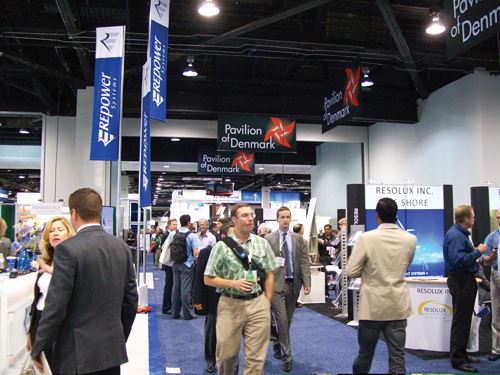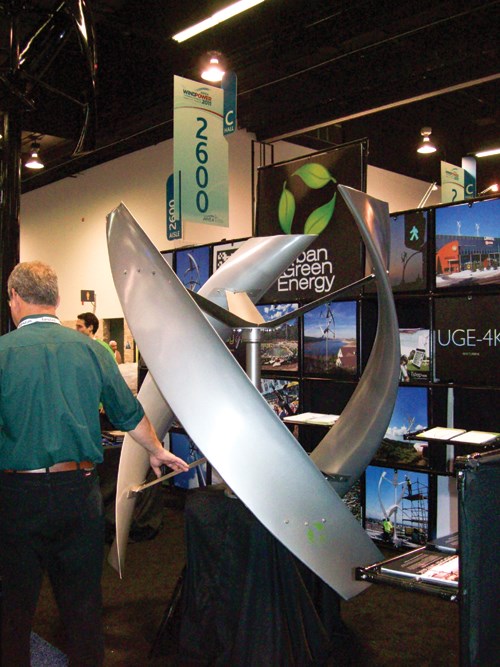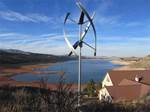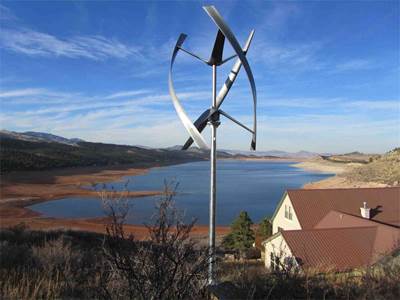WINDPOWER 2011 Report
Wind energy advocates, turbine builders and their suppliers, policy makers, and a growing number of wind-involved composites professionals gather where it all began.
This year, the American Wind Energy Assn.’s (AWEA, Washington, D.C.) WINDPOWER 2011 Convention & Exhibition returned to the source, California, where the industry got its start 30 years ago. More than 1,100 exhibitors made the trip, for the world’s largest annual wind-energy event. The show filled all four exhibition halls and a large portion of the Center’s lower level — 20 football fields of total exhibit space.
AWEA reported that, today, U.S. wind farms contribute more than 41,000 MW of installed capacity, enough to power 10 million households. The U.S. is now second only to China, after installing 5,115 MW in 2010, although that figure was down from the high of 10,000 MW installed in 2009.
At the opening general session, AWEA CEO Denise Bode noted California’s recent wind renaissance, the product of the state legislature’s enactment of the most ambitious renewables goal in the U.S. — 33 percent by 2020. As a result, 600 MW of wind power are now under construction in the state — more wind capacity than the state has installed in any single year in the last decade. When those megawatts come online, almost 1 million California households will be powered by wind. However, the AWEA confirmed that the Midwestern U.S. now dominates wind development news. And although its first wind farm is yet to be built, the winds of change are beginning to blow to the Southeastern U.S. as well.
U.S. wind (finally) blowing offshore
AWEA also announced that this year is already guaranteed to be the best yet for offshore wind in the U.S. As reported in CT (see "U.S. approves ...." under "Editor's Picks," at top right), Secretary of the Interior Ken Salazar and Secretary of Energy Steven Chu have unveiled a coordinated strategic plan, A National Offshore Wind Strategy: Creating an Offshore Wind Industry in the United States, intending 10 gigawatts (GW) of offshore wind capacity by 2020 and 54 GW by 2030. They announced $50.5 million in funding opportunities for projects that support offshore wind energy deployment. Also in February, Salazar announced the creation of high-priority Wind Energy Areas (WEAs) in Delaware and Maryland and off the coasts of New Jersey and Virginia, and outlined plans to identify additional WEAs off the coasts of both Massachusetts and Rhode Island.
Keynote speaker, CNN Broadcasting founder and the force behind the Turner Renewable Energy venture, Ted Turner echoed the calls of other wind advocates for stable policy incentives, such as the soon-to-lapse Production Tax Credit (PTC). “They must be long-term incentives so we can plan intelligently,” he said.
At a Manufacturers and Suppliers Panel on Tuesday, major turbine manufacturers took up that refrain, estimating about 13 GW of new installed capacity during 2011-2012, globally, but emphasizing that all bets are off for 2013 because U.S. tax incentives expire in 2012. The panel named long-term priorities as clean-air and energy standards and a transmission policy that would level the playing field and put wind on solid footing in competition with other resources. Significantly, it was reported that as rotor blades get longer to take advantage of economies of scale, tower manufacturers, who almost exclusively work in steel, are finally looking at composites to enable lighter, taller towers.
In a later session on Blade Design, participants from Wetzel Engineering (Lawrence, Kan.), Zoltek Corp. (St. Louis, Mo.) and Hexcel (Stamford, Conn.) encouraged the use of carbon tow in blades to increase stiffness and reduce weight, especially for large offshore machines. Hexcel has opened a site in Windsor, Colo., for production of materials for the wind industry, claiming that a 13 percent weight reduction in spar caps produces a 33 percent savings in the number of unidirectional prepreg layers in the cap, adding up to a 3.7 percent savings overall in the blade. That earns a reduction of roughly $1,200 material and $750 in processing cost per blade.
On the show floor
The show hosted a fair number of OEMs in the “small wind” segment — those manufacturers whose turbines generate less than 100 kW of energy (see CT’s “Market Outlook” for this wind-energy segment, titled "Small wind gets big," under Editor's Picks," at right).
Saito Shungo, senior manager of sales with NIKKO (Irving, Texas), was marketing EOLIA 1,000-watt wind turbines for private home use. Although new to the U.S. market, Saito noted that zoning restrictions are likely to keep small wind turbines out of incorporated residential developments, but rural communities are strong targets. NIKKO’s $5,000 turbine, (pole, hookups are extra) reportedly can, in good wind locales, turn a 10-year payback. He says that in Europe, utilities often are legally bound to buy back power from turbine owners at a higher rate than the utility charges for power, as an incentive to development. He sees the “community wind” movement, where a group of homeowners, for example, erect a co-owned turbine in a remote site, as the key for suburban and urban locations.
The show floor was dominated, of course, by those who serve the utility-scale end of the turbine market. Blade manufacturer LM Wind Power (Kolding, Denmark) was on hand, reiterating its commitment to infused, room-temp-cure glass/polyester blades. LM touted its 61.5m/202 ft blades for 5- and 6-MW offshore turbines installed by REpower (Hamburg, Germany) in water as deep as 30m/98 ft in the North Sea and Irish Sea. LM said it was testing even longer blade for Alstom Power’s (Levallois-Perret, France), new 6-MW offshore turbine.
Composites suppliers predict fair winds
Gurit UK’s Lance Hill, head of sales, wind energy, one day in, was already declaring business good, and told CT that wind now accounts for half of Gurit’s annual business ($200 million USD) but noted that this percentage is actually down from previous years “because we’ve added marine.” (Gurit recently bought New-Zealand-based High Modulus, renaming it SP-High Modulus, the marine unit of Gurit.) Five years ago, it was a greater percentage of its business, but today it is nevertheless a bigger revenue source than ever, in terms of dollars. Europe and China are Gurit’s principal areas of growth. Notably, Hill claims that carbon fiber goes into 25 percent of the blade product that Gurit services, and he sees that percentage growing especially as blade length increases beyond the 55m/180-ft mark.
Magnum Venus Plastech’s (MVP, Clearwater, Fla.) Tim DeLuca and Jeff Austad noted that while wind is but 5 to 10 percent of the company’s business, their efforts to market their closed molding system and other composites processing tools to the wind blade manufacturers at this show in the last four years is bearing fruit. Although a federal tax credit requirement, that up to 80 percent of a wind turbine be produced on U.S. soil, has contributed to greater interest, they credited the testimony of shop techs who migrated to wind blade builders from marine composites shops during the 2009-2010 recession: The techs reportedly lobbied wind employers on behalf of MVP’s product offerings products. DeLuca and Austad claim that each major U.S. blade makers now uses MVP closed molding equipment in some portion of their operations.
At the DIAB Sales Inc. (DeSoto, Texas) booth, Sam Cato, regional sales manager, told CT that wind now makes up a whopping 70 percent of DIAB’s business. When the marine market took a nose dive, he explained, the wind market made up for the lack. Although wind blade manufacturers spec a number of different core materials, he says the two most common are balsa and PVC foam. Cato noted that while Europe, at least for the moment, looks flat, the U.S. is growing and should continue to grow. He noted that its relative youth gives the U.S. market a boost. In Europe, much development has occurred, especially offshore, while the U.S. has yet to exploit its opportunities. New offerings in the booth included Divinycell Matrix rigid polyvinyl chloride (PVC) foam core material, designed for optimum strength-to-weight and good peel strength. Also in the spotlight: the company’s Composites Consulting Group’s (CCG) four-day Infusion course, designed for laminators, engineers, designers and managers who have a basic knowledge of composite molding and resin technology.
Side-by-side with its Closed Molding products display at the Composites One (Arlington Hts., Ill.) booth was a companion display of the distributor’s array of materials and processing supplies for repair and service of composite structures, reflecting the growth of repair and maintenance organizations as older turbine blades suffer tip erosion and damage from bird and lightning strikes.
PPG Industries’ (Pittsburgh, Pa.) Laurie Cochran, branding/communications specialist, said PPG is marketing not only glass fiber product (its Hybon direct rovings and TufRov LFT) but also coatings and protective sheathing designed for blades and towers. Blade coatings included high-solids but low-VOC Durablade products, including AGC-200 (clear) and AGC-10000 (pigmented) urethane gel coats, AUE-50000-series erosion-resistant polyurethane topcoat and HSP-7401 polurethane primer. Cochran told CT that wind and automotive are the company’s two biggest composites segments and sees growth ahead for both.
Wind industry growth tempted 3M (St. Paul, Minn.) back into manufacturing composites products after its composites-related resins and adhesives quietly lost steam more than a decade ago. Its return, announced in early 2010, part of a larger push into the renewable energy market, has spawned several product introductions that, says Tony Kremer, senior tech specialist in 3M’s Renewable Energy Division, are the first in an expected comprehensive product line that will include not only its 3M Matrix Resins, but its new Wind Blade Bonding Adhesive W1101, for the critical interface between molded blade halves. The two-part epoxy is designed to improve on epoxies currently used by blade manufacturers. According to Kremer, existing epoxies take up to eight hours to cure and tend to be brittle and, therefore, subject to stress cracking. W1101 epoxy is toughened and, he says, tests at double the crack resistance and three to four times the peel strength. Also, 3M is touting its acquisition of core materials suppler Nida-Core (Port St. Lucie, Fla.) which gives 3M the core materials to complement 3M’s resins, adhesives, surface protection and coating product lines for the blade manufacturer.
VISTAGY Inc. (Waltham, Mass.) announced that onshore turbine maker Nordex (Hamburg, Germany) has purchased FiberSIM software to streamline its entire design-to-manufacturing process for composite wind turbine blades. The engineering suite will be used to develop detailed blade ply designs and layups, generate accurate flat patterns and provide complete documentation for the engineering release. FiberSIM is fully integrated into the PTC Creo Elements/Pro, Dassault Systèmes CATIA, and Siemens NX CAD systems. “Transferring data between design and analysis can be extremely time-consuming,” said Hendrik Klein, chief designer in the Nordex Rotor Blade Division. “But during the testing phase, we recognized that if we had a design tool that had a seamless interface to our CAE analysis tools, it would enable us to significantly reduce the product development cycle.”
CASS Polymers (Madison Hts., Mich.) unveiled a tooling concept that uses a sandwich structure, featuring composite facesheets and either of two “tooling dough” cores from the company’s ADTECH division: ADTECH EL-323 TC room-temperature or EL-325 HTTC high-temperature, pliable epoxy tooling compound is applied to the back of a fiber-reinforced epoxy tool face to any thickness greater than 0.25-inch/6.35-mm, without excessive exotherm. The cured compound forms a dimensionally stable, tough, lightweight core that can be machined, drilled and tapped. A fiber-reinforced epoxy backface completes a sandwich that will exhibit high stiffness.
Creative Foam Composite Systems (Fenton, Mich.) offered custom-shaped foam for rotor blade cores, using lightweight core from multiple sources to meet core kitting needs. Capabilities include rapid prototyping, 5-axis CNC routering, 3-D mold math data, complex 3-D curves in thermoplastic core materials.
Dynabrade Inc. (Clarence, N.Y.) spotlighted its rotating hand tools for grinding and sanding composites (and steel) for the wind and other industries — all with integral dust collection — and appeared to be the only company at WINDPOWER offering these products.
The recently christened ITW WindGroup was there in force: ITW Insulation Systems (Houston, Texas) featuring its TRYMER L-series polyisocyanurate foams; Schnee-Morehead (Irving, Texas) brought its advanced sealant technology to the show; and ITW Plexus (Danvers, Mass.) touted its structural adhesives for manufacture and repair of wind turbine blades, nacelle assemblies, lightning suppression systems and other industry-related applications.
Lectra (Paris, France) said it has fielded 65 cutting machines in the wind industry to date. Each is fitted with reciprocating carbide blades suitable for cutting glass and carbon patterns for rotor blade and other composite parts layups.
SIKA Corporation (Zurich, Switzerland, and Madison Heights, Mich.) offered a full range of bonding, sealing, damping and reinforcing products and solutions to the wind industry, from the wind turbine’s base foundation to the tip of its blades. The products are said to be capable of withstanding the tough climatic conditions of high-wind areas on land and sea.
Polyurethane and epoxy systems developer Dow Formulated Systems (Midland, Mich.), said its trademarked COMPAXX 700 foam core system for wind blades, the first in a line of new core materials designed to extend blade life through the creation of high-performance sandwich composites, is now commercially available worldwide. Extensive sandwich panel fatigue testing (per Germanischer Lloyd requirements) reportedly shows that the new foam exhibits long-term dynamic behavior and shear-strength properties, yielding lightweight composites with high mechanical strength and fatigue resistance. Dow also announced the completion of a new wind blade epoxy adhesive production plant in Roberta, Ga., dedicated to the wind energy sector in the U.S. market as well as exports to China and Latin America. The plant commenced operations in July of this year.
Related Content
Drag-based wind turbine design for higher energy capture
Claiming significantly higher power generation capacity than traditional blades, Xenecore aims to scale up its current monocoque, fan-shaped wind blades, made via compression molded carbon fiber/epoxy with I-beam ribs and microsphere structural foam.
Read MoreNovel composite technology replaces welded joints in tubular structures
The Tree Composites TC-joint replaces traditional welding in jacket foundations for offshore wind turbine generator applications, advancing the world’s quest for fast, sustainable energy deployment.
Read MoreNovel dry tape for liquid molded composites
MTorres seeks to enable next-gen aircraft and open new markets for composites with low-cost, high-permeability tapes and versatile, high-speed production lines.
Read MorePlant tour: ÉireComposites, Galway, Ireland
An in-house testing business and R&D focus has led to innovative materials use and projects in a range of markets, from civil aerospace to renewable energy to marine.
Read MoreRead Next
Small wind gets big
Massive growth, complex blade designs reopen challenging market in wind energy niche.
Read MoreCW’s 2024 Top Shops survey offers new approach to benchmarking
Respondents that complete the survey by April 30, 2024, have the chance to be recognized as an honoree.
Read MoreFrom the CW Archives: The tale of the thermoplastic cryotank
In 2006, guest columnist Bob Hartunian related the story of his efforts two decades prior, while at McDonnell Douglas, to develop a thermoplastic composite crytank for hydrogen storage. He learned a lot of lessons.
Read More






















.jpg;maxWidth=300;quality=90)







